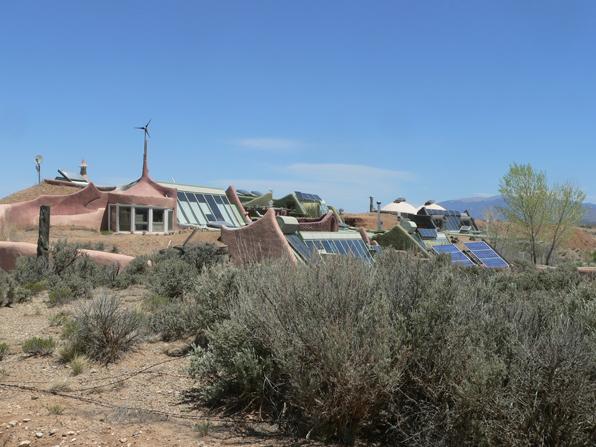Our recently completed collaboration with ACI design:build, the Bacus Residence in South Boulder, will be one of the participating sites on the Boulder Green Home Tour. The tour is...
earthships
I'm not really sure what to make of these things.

You may have seen them in the popular press or doting the landscape northwest of Taos, NM. Started in the early 1970's by Michael Reynolds, these experiments in radical sustainability are called Earthships and though centered in the high desert in New Mexico, their prototypes have been adapted and built in every state of the US. Long before "green" building was in vogue, these house were the first sustained experiments in living off the grid, using recycled materials and proto-"green" construction.
Michael Reynolds was the first architect that was largely responsible for many of these buildings and certainly the dominant philosophy behind the work. Most of the homes are made from earth-filled tires creating extremely dense thermal masses allowing the buildings to remain warm in winter and fight off the unrelenting summer sun of the high desert.
These are not simple some early 1970's hippy creations, but an ongoing community with houses available for nightly rentals, construction workshops and a growing international outreach. You will be hard-pressed to find anything in the architectural press about these buildings other than some notations about their technical difficulties and achievements. Little or nothing is found about the strange formal qualities that are remarkable consistent in at least the Taos-based homes. If anyone knows of any discussion of style and form of these buildings let me know. Short of some bad sci-fi movies, I can't seem to place the look and feel of these places.
Earth Day 2011
On this celebration of Earth Day it is tempting to post about all the sustainability efforts and green productsthat we have integrated into our work. Here in Boulder, the installation of solar panels, integration of geothermal ground source heat exchange systems, advanced framing techniques, etc. are so commonplace that they have become a standard part of every architect's practice. Sitting on the Landmarks Board, weekly I hear the stories of homeowners upgrading windows and insulation, caulking and duct-sealing. A blower-door test is used more frequently than a soils test.

These are all important and necessary techniques and processes that should be brought to bear on every project. But they do not address the most compelling issues of how we inhabit the land. Not even the quest for greater density and less sprawl and impact speak to what I believe is the most crucial problem of the built environment. It is the more subtle and less ostentatious attitude of how a building sits on and within the earth that I believe is the most important problem that an architect can tackle.
When we dig into the earth to make a building, and we almost always start with digging, how do we resolve the desire to make a place on the earth with a passion to protect that same landscape. How do we honor, and maybe even enhance, the land we initially dig up, blast out and push around?
We could make no building there.
We could make a beautiful building there.
We could make a building that will last a thousand years.
We could make a building that everyday allows the homeowners to see the landscape as integral and necessary to their lives. We could make buildings that forever sever the man vs. nature paradigm that has marked so much of our attitude to the land. We could make a building that makes present the wind and sun, that frames the moon and stars and our place among them.






